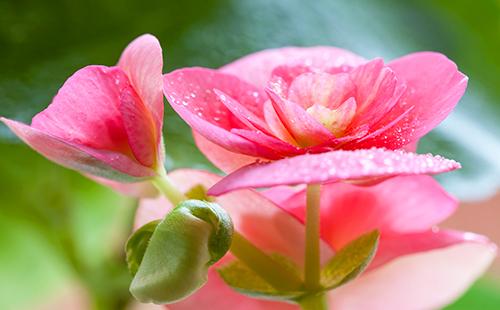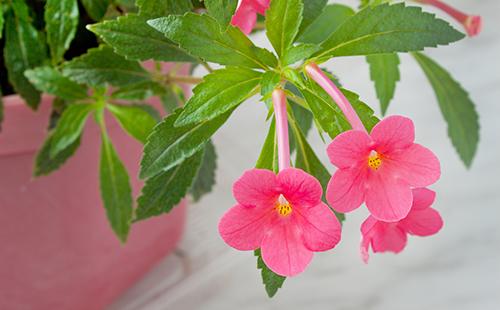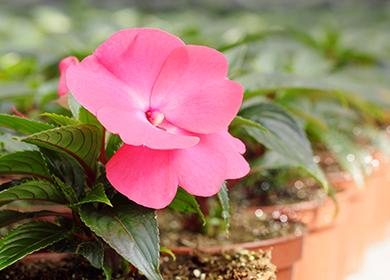The content of the article
The plant with a bizarre name belongs to the genus Gesneriaceae and is considered the most beautiful and magnificent member of this flower family. In addition, it can be safely attributed to ampelous representatives of the flora - that is, to plants with flowering shoots, which are usually grown in hanging pots or pots and used to decorate the interiors of balconies, terraces, loggias and other rooms in the house. An impromptu hanging flowerbed impresses with its thick colors and rich color.
Growing Achimenes at home is a task that even a novice gardener can do. The plant is not used to being capricious due to improperly selected location or direct sunlight. It is ready to pamper the hosts with bright colors from late spring to late autumn under only two conditions: the absence of drafts and the abundance of sunlight.
Plant species
Data on the types of flowering Mexican differ from source to source. But it is clear that in nature there are several dozen varieties of this plant - presumably from 30 to 60. Each variety is unique, each has its own admirers from among amateur gardeners around the world. Conventionally, “domesticated” varieties can be divided as follows.
- Hybrid. Artificial flowers using controlled pollination of two specific parental varieties.
- Long flowered. A view of ampelous achimeneses, the length of branches of which reaches 30-40 cm and which can be safely planted in hanging flower pots, decorating them with a terrace or a veranda - to the delight of the owners and the envy of the neighbors passing by the house.
Hybrid varieties
The hybrid varieties described in the table are an ideal choice for a window sill in a city apartment. Knowing how to care for Achimenes, you can easily grow a miniature tree "dotted with bright flowers" in a pot.
Table - Top 3 Hybrid Varieties of Homemade Achimenes
| Grade name | Features |
|---|---|
| Little Beauty | - Multiple bright pink flowers |
| Claudid Yellow | - Yellow flowers with a pink border around the edge of the petal |
| "Cameo Triumph" | - Plant with abundant bright yellow flowers |
For the representative of the flora under discussion, it is extremely important to observe the rules of seasonal care. Not only the plant's health and well-being, but also the abundance of color depends on the quality of care. Hybrid residents of window sills, as a rule, are somewhat more demanding and capricious of their purebred counterparts.
Reviews of the long-flowered achimenes are unambiguous in their conclusions: the plant is ideal for ampel landscaping and turns an ordinary terrace into a flowering fairy garden. The most popular species of Achimenes, which are grown in hanging baskets, are described in the table.
Table - Top 8 Amplified Achimeneses
| Grade name | Features |
|---|---|
| Major | - This variety of Mexican handsome gives the largest flowers; - sometimes one flower reaches a diameter of 8 cm |
| Chiapas | - The light purple flowers of this shrub are visible from afar; - the edge of the flowers is wavy, like a skirt at the Turgenev girl |
| Haage | - Differs in large flowers; - characteristic feature - thick purple flower pharynx |
| Juaregia | - The diameter is slightly smaller than that of the Major variety, but still impressive - 6 cm |
| Clouded yellow | - The shrub exudes a light sweetish aroma; - medium sized flowers |
| Mexican | - Lush variety with small purple flowers; - in appearance, the flower is very similar to gloxinia |
| Misera | - The small flowers of this achimenes are painted white; - in the throat of flowers there are always purple spots; - velvet leaves, in small villi |
| Snow white | - Shrub with snow-white flowers; - the pharynx of flowers is slightly colored yellow |
Achimenes care: must do
It’s very easy to cater to the tender bell, which in the summer turns the window sill into a fabulous flower garden. The principles of care are elementary and easy to remember.
Lighting
The Achimeneses are fans of a lot of light, so lighting is given maximum attention when growing Mexican beauties. It is important that the location of the flower location is closer to the window. But under direct sunlight, a miracle flashlight should not be substituted.
Temperature
No wonder the flashlight is considered a balcony plant. In the summer heat, an open loggia, porch or balcony with a temperature of 22-24 ° C is an ideal place for a flowering handsome man. It is important that the temperature regime is stable. Temperature fluctuations badly affect the health of the plant.
Humidity
Miracle lanterns love moist air. If the humidity level in the room is below 50%, the plant begins to dry out and wither. This moment can be controlled using a household hygrometer and a humidifier. But you do not need to spray the plant under any circumstances. Abundant spraying is the most common reason why Achimenes does not bloom at home.

Watering
Miracle flashlight during flowering should be watered often enough. As soon as the top layer of the earth dries, water should be added to the pot at room temperature. But to fill the plant is contraindicated. Due to a supersaturation with moisture, Achimenes can develop diseases.
Pests
The worst enemies of Achimenes are thrips and a red spider mite. To eliminate the first pests, experts recommend the use of insecticides. And to get rid of the second - acarcides.
Fertilizer
The principles for feeding Achimenes are exactly the same as for most other plants:
- no need to fertilize immediately after transplantation;
- further feeding should be done no more than twice a month.
Spring awakening
The hectic life of Achimenes begins in mid-February. This time is considered ideal for planting rhizomes (rhizomes). To understand that the rhizome is ready to go to the underworld for further growth and development is very simple. If there is a formed germ on the rhizome, it means that the rhizome can be safely planted in the ground.
The composition of the light substrate for planting Achimenes should ideally be as follows:
- leaf land - five parts;
- sand - two parts;
- peat - two parts;
- dry mullein - one part (as fertilizer).

How to plant rhizomes
If you have purchased a new cultivar of Achimenes for home growing, when the first signs of a sprout appear, you need to prepare a pot and soil. We proceed in four steps.
- We place the rhizome horizontally on the ground in the center of the pot.
- Sprinkle it with earth. The layer should be minimal, no more than 2 cm thick.
- Moisten the pot a little.
- We put it on a windowsill or in another place with plenty of sunlight.
Akhimenes care after transplantation does not imply abundant watering. The soil needs only to be slightly moistened, in no case filling the planted rhizome. The average frequency of watering is once a week. When at least six full sheets appear, the stronger achimenes will need to be transplanted.
If Achimenes does not want to branch
Typically, Mexican beauties grow a lush spherical bush. However, there are also archers who stubbornly do not want to branch. If you come across such a capricious miracle flashlight, remember how to pinch achimenes. This should be started no earlier than the moment when the sprout reaches a height of 3 cm and at least four leaves appear on it. Act in four steps.
- Remove the growth point by doing this as carefully as possible.
- Wait for the germination of shoots over the top pair of leaves.
- Let them grow a little stronger.
- Pinch off the top leaves, leaving only one leaf pair on the sprout.

Principles of care
Unlike other flowers, the miracle flashlight, although a foreigner, is very simple in primary care. Answering the question of how to care for Achimenes in the spring, it is worth listing the three most important principles.
- Maximum sunlight.
- Minimum moisture.
- No drafts.
And also - no spraying. This is not Benjamin's ficus, ready to bathe in a warm shower every day. Subject to the rules of primary care, after a couple of months, a full-grown shrub ready for flowering will appear on your windowsill.
Breeding
There are four ways to propagate the Mexican living on your windowsill. Choose the most acceptable and produce Achimenes.
- Seeds. Seeds can be purchased. And you can get it at home. To do this, you should know how to pollinate Achimenes at home - without the help of animals and insects. In fact, nothing complicated. With a finger or a brush, you need to take pollen from one flower and transfer the pistil of another to the stigma of a flower. Seed propagation involves planting seeds at a temperature of more than 20 ° C. For planting, you must use a mixture of perlite and peat.
- Cuttings. Closer to winter, when the plant begins to prepare for hibernation, it is necessary to break off a healthy stem at the base. From it you need to remove all the buds and top leaves. To root the stalk of Achimenes, one pair of leaves from the bottom will be enough. After the prepared stem is planted in a pot, covered with polyethylene or a jar and thus creating a miniature greenhouse.
- Leaves. To propagate achimenes leaf, you need a large enough young leaf. To root it, experts advise using peat moss. After rooting, you need to organize a greenhouse.
- Rhizome division. Propagation of Achimenes by dividing the root into small fragments 3-4 cm long is an effective way to obtain “offspring” from your favorite domestic flower. The optimal time for applying the method is the beginning of spring.
With the advent of autumn, exactly the same thing will happen with the plant on the windowsill as with chestnuts and maples under your window. The leaves gradually turn yellow, and after falling off - all to one. This is a common occurrence, so you should not worry. Gradually stop watering the flower, and remove the dried stems with scissors or secateurs. Now this once flowering handsome man is completely ready for hibernation. How to store ahimenes in winter? Put the pot in a cool, dark place and do not disturb until February. Give the shrub a good rest and only occasionally moisten a container with rhizome gradually. At this point, the story of growing Achimenes at home comes to an end. But not for long, but only until next spring, which is just around the corner.
Reviews: “This is a flower-paw”
I first met this plant about 25 years ago, he grew up at our work, but no one knew where "he came from and what his name is." Over time, I found out the name of the stranger - Achimenes. Since then, we have not met, for some reason they did not sell it in any flower shop. And only in January of this year I found an online store where they sold rhizomes (rhizomes) of varietal Achimenes. From impatience I decided to pick it up at home. In the cold, on the crossroads, the devil went where, to some village near Bronnitsy for the long-awaited flower. The price, by the way, be healthy, 200-250 rubles. for a rhizome the size of a grain of lemon, but it suited me. I drove home in a corset so as not to freeze the purchase. I bought 4 grades, the fifth was given as a gift. In winter, Achimenes sleeps, the entire aerial part dies. Planted rhizomes in pots in February (planting depth about 2.5 cm), waited a long time for tiny sprouts (appeared in April), slightly moistening the soil. When it got warmer, I carried it out onto the balcony, protecting it from the scorching sun. Flowering began in late May. Watering, especially in the heat should be plentiful, but not flood. Fertilized with a drug in the form of sticks for flowering plants. Now two are blooming, and three are still very small and without buds, apparently, I got very small roots, but, most importantly, they grow. Flowering will be until October, but as soon as the temperature drops to +15, the Achimenes will stop blooming and begin to prepare for winter - it will be necessary to reduce watering and all over again (sleep in almost dry land until February). A very beautiful and interesting flower, especially convenient for those who do not have enough space in the winter on the windowsill.
Svetlana Yurievna, http://irecommend.ru/content/ochen-dolgo-iskala
I got my plant from a piece of rhizome. I don’t remember exactly where I bought it, but I remember very well how I eagerly awaited its germination, watched with trepidation the small tender seedlings. Then came flowering, which was plentiful, vibrant and colorful. My Achimenes grew up on the south balcony, but it was shaded by a fairly dense curtain. The flower felt wonderful in such conditions, I do not remember any problems associated with its cultivation. The only thing I didn’t really like about the plant was its rest period. Although most flower lovers, on the contrary, really like this property, I always had problems with storing wintering flowers up to the point that I could forget to pull them into the light when spring comes. Sometimes it’s very important, because the plant can begin to develop in the dark and forms white very weak seedlings, which will then have to be trimmed.
Happyflora, http://happyflora.ru/view_post3.php?latter=45
Oh, well, it's such a flower-paw) Tropical, Brazilian, you can say)) It disappears in the winter, appears in the spring, blooms in the summer and pleases you until the end of the season with its rich purple flowers - lights. True, he has different colors, I met red achimenes, but I prefer lilac-purple, like mine. In general, I have a weakness for the colors of blue shades, since this is quite rare in nature.
Ahimenez belongs to the same family as everyone's beloved home violets - the Gesnerius family. He has stems and leaves softly pubescent. But in autumn the whole vegetation ends and only small scaly nodules remain in the pot. They do not need to be watered until February, and it is better to put the pot in a cool dark place. Sprouts will hatch in the spring - then start watering.
In a pot, achimenes is formed as a naturally scattered bouquet - this is a very picturesque sight, it has thin long stems with drooping bells of flowers. If you pinch the spring shoots, you will end up with a very lush bush that will delight you until mid-autumn.
In flowers, the petals are very turned outward and a flower of about 1-1.5 cm in diameter is obtained. This is a lot. But I saw in good conditions, in the greenhouse, the exact same variety with a giant flower size! That's what suitable humidity and a spacious pot mean.
The soil for this plant should be light, with an admixture of sand. Stagnant water can be harmful, as well as violets, and all gesneriae, so drainage is recommended. The place is away from the direct sun.
In general, I think it is not a whimsical flower, he has been living with me for about 20 years. I have to work very hard to lime it))ElzaTriole, http://otzovik.com/review_614702.html

